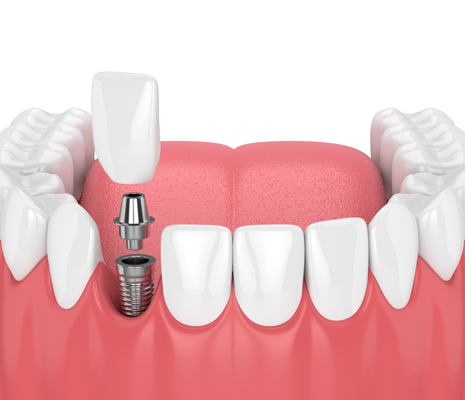Making Your Implant Crowns Last

Implant crowns are typically recommended when an implant is being used to replace a lost tooth. This artificial teeth root is surgically inserted into the patient’s jaw. The implant fuses with bone tissues around it through a process known as osseointegration. As a result, bite forces are transferred through the implant crown and implant to the person’s jaw, stimulating tissues and preventing the bone tissue breakdown that can happen when a tooth is lost.
Getting the most out of implant crowns
Implant crowns are ideal long-term options for replacing teeth. These restorations look like natural teeth, and they do not require anything besides brushing and flossing to keep them in great condition. The implant that the crown sits on is typically made out of titanium, and it is designed to last a lifetime. Implants crowns can last up to 30 years when properly cared for. Simple things that can be done to make an implant crown last longer include:
- Good oral hygiene: Crowns are not vulnerable to the acids made by oral bacteria, but the gum tissues that support them are; good oral hygiene helps remove plaque deposits and prevent stains from forming on the crown
- Avoid hard foods: An implant crown is designed to handle tremendous bite forces, but it is not as durable as real teeth, so hard foods like ice or hard candies can lead to a crown becoming damaged; people with crowns should also avoid using their teeth for things that they are not designed for, like opening packages
- Use appropriate mouth protection: People with crowns should take extra steps to protect their teeth from forces that they are not designed to withstand, including wearing a mouthguard when engaged in contact sports or a nightguard to reduce the effects of teeth grinding
What to expect when getting an implant
Dentists often recommend implants for missing teeth replacement due to their bone-preserving properties. Other missing tooth replacement options, like dentures and bridges, do not address bone deterioration. Patients must be assessed to determine if they are healthy enough for implant surgery.
Replacing a missing tooth with an implant can take over six months. The first step is inserting the implant into the patient’s jaw. A local anesthetic is administered, and the dentist might have to make an incision to reach the patient’s jaw.
A hole is drilled into the jaw, and then the implant is placed in it. Bone tissues around the implant hold it in place via friction, the same way that wood holds a nail in place. In some cases, an implant crown might be attached during the same visit, or the dentist might wait for the implant to fuse with the patient’s jaw.
Implant crowns provide a long-term solution for missing teeth
Are you missing one or more teeth? Call or stop by our San Diego clinic to set up a consultation with our dentist.
Request an appointment here: https://scrippsranchdentistry.com or call Scripps Ranch Dental at (858) 222-6164 for an appointment in our San Diego office.
Check out what others are saying about our services on Yelp: Implant Crowns in San Diego, CA.
Related Posts
Those missing one or more molars may benefit from dental implants. The molars are the large, flat teeth in the back of your mouth, used to grind your food when chewing. Not counting your wisdom teeth, you have eight molars in your mouth, all of which play an important part in your ability to chew…
Dental implants are becoming a very popular choice for replacing missing teeth. Many patients ask about implants because they are known to look and feel the most like natural teeth. Any person could need to replace a missing tooth or teeth for a variety of reasons. You may not have kept up on your oral hygiene…
A dental implant restoration is a method of teeth replacement that offers long-term durability and a natural feel and function for patients. It involves the placement of a dental implant (a titanium dental post) into the jawbone, followed by attaching the abutment and prosthetic (crown, bridge or denture). The dental implant restoration process involves a consultation…
A restorative dentist is the go-to dental professional for repairing damaged teeth. While this specialist undergoes general dentistry training to learn how to provide routine care for the teeth, they specialize in repairing damaged teeth via treatments like dental fillings. In fact, dental fillings can go a long way in restoring damaged teeth. Keep reading…


